Top News
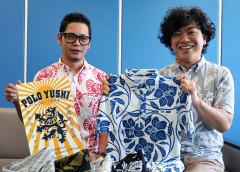
June 30, 2011 Ryukyu Shimpo
A polo shirt version of kariyushi wear is selling well.
Kariyushi shirts were originally created as business wear during summer in Okinawa and are designed based on Hawaiian shirts but with uniquely Okinawan cultural motifs.
Project Core Inc. (president Bokunen Naka), which works on original product development in Yomitan Village, has commodified a polo shirt version of kariyushi wear.
The poloyushi shirt is sold in HabuBox, a T-shirts store operating four branches in the prefecture.
Sales of the shirt started from the Golden Week holidays, attracting not only local customers but also tourists from outside the prefecture. Its popularity has been on an upward curve ever since, in fact so much so that production cannot currently meet demand for some types of poloyushi shirt.
Taichi Naka, the director of Project Core Inc., said, “We developed the poloyushi shirt based on the concept of putting forward a new style unique to Okinawa. Taxi companies, real-estate agencies in the prefecture and hospital facilities in other prefectures have started adopting poloyushi shirts as their uniforms. The shirt is used not only in the resort industry but also in business settings and is creating a new trend in casual clothes in Okinawa. We hope that it might help vitalize the economy of Okinawa.”
Sales of poloyushi shirts commenced from 2009, and to start with, Project Core manufactured products themselves, but of course this meant that the price was relatively high at 9800 yen per shirt including tax. Now, the company designs the shirts in Okinawa but manufactures them in China, allowing them to keep the price down to 5500 yen (tax included) per shirt, and therefore to give a new lease of life to the poloyushi shirt concept. Nakama said, “The poloyushi shirt has succeeded in attracting new customers because of the Cool Biz campaign (the name of an energy-saving campaign the Japanese government instituted in 2005) has been revisited due to the need to save electricity in the Tokyo Metropolitan area.”
There are four types of poloyushi shirt in the motif of various designs such as a flower block, which is a design used for concrete block walls in Okinawa, hibiscus and galingale.
Each of the shirts comes in two colorways and six different sizes from SS to LLL.
Takeya Uehara, of the design planning division of Project Core said, “We created designs that aim to make customers imagine Okinawa.”
The company is scheduled to release seven new types of poloyushi shirt in the middle of July.
For further details, call HabuBox, AKARA branch at 098(936) 8239.
(English Translation by T&CT, Mark Ealey)
Go To Japanese
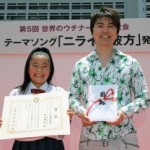
June 30, 2011 Ryukyu Shimpo
Nirai no Kanata (Beyond Nirai) was selected as the theme song for the 5th Worldwide Uchinanchu Festival, which is scheduled to be held over four days from October 13.
Composer Katsushi Arakaki wrote the music and lyrics and Natchy (her real name is Nanami Yamada, a second year student at Okinawa Higashi Junior High School in Okinawa City) sings the song.
A press conference and award ceremony for the selection of the theme song was held at the Kenmin Hiroba in Naha on June 29. Natchy gave it her all when she sang at the ceremony.
A total of 18 entries for the theme song were received from both home and abroad.
Hidenobu Chinen, the head of the Executive Committee for the festival, delivered a congratulatory speech, saying that Nirai no Kanata was head and shoulders above all the other entries.
Arakaki said, “Uchinanchu went abroad in search of their dreams and hopes. I wrote this song in the hope that the feeling for Okinawa from people in foreign countries and that of overseas immigrants’ for Okinawa could be brought together, giving a tremendous boost to the festival.”
Natchy said, “I would like to sing this song to help convey all that is good about Okinawa.”
The lyrics of the song say, “Echo the soul of this beautiful island like a smile taught by a red flower. Bring a prayer from this beautiful island. Beyond Nirai, a prayer for peace for all eternity.”
Nirai is the place beyond the oceans which ancient Okinawan people believed was the world of gods.
(English Translation by T&CT, Mark Ealey)
Go To Japanese

June 29, 2011 Ryukyu Shimpo
At a regular meeting on June 29, the Okinawa Prefectural Assembly (Chairman Zenshin Takamine) unanimously passed a resolution and statement of protest against the U.S. military parachute drill held at Kadena Air Base on May and seeking the revision of U.S.-Japan Status of Forces Agreement (SOFA).
In the resolution, the Assembly demands a stop the U.S. military parachute training at the Kadena Air Base, saying, “Military officials suggest that they can conduct any training at the base anytime they like. In our view, this is not acceptable.” The assembly protests, stating that, “The Japanese government consents to the U.S. military’s unilateral approach to such things.”
A U.S. military civilian employee recently caused a traffic accident in Okinawa City in which a local was killed but the individual at fault was not prosecuted. In relation to this issue, the assembly calls for the revision of the SOFA, pointing out its shortcomings, saying, “The U.S. military is soft on punitive action towards its own people and their criteria for judging whether those people are on official duty or not leaves a lot to be desired.” The Naha Committee for the Inquest of Prosecution determined that the person who caused the accident should be indicted.
The written statement of opinion will be sent to Prime Minister, the Foreign Minister and the Defense Minister of Japan. The resolution of protest will be sent to U.S. Ambassador to Japan and to U.S. government officials such as the U.S. military commander of U.S. Forces in Japan.
Members of the Assembly will visit the Consulate General of the United States and other organizations in Okinawa prefecture to make a direct protest.
(English Translation by T&CT, Mark Ealey)
Go To Japanese
June 30, 2011 Ryukyu Shimpo
The film Yagi no bouken (The Catcher on the Shore), which Kyuyo High School first year student 15 year-old Ryugo Nakamura directed when he was still a pupil at Okinawa Higashi Junior High School in Okinawa City, has been recently screened at several international film festivals.
The film was screened in the International Film Panorama section of the 14th Shanghai International Film Festival from June 11 to 19, just before it was officially decided on June 29 that it would be screened in the Children of Heaven section of the 13th Seoul International Youth Film Festival from July 7 to 13 and in the competition section of the 3rd Shinsedai Cinema Festival Toronto (The New Generation Japanese Film Festival) from July 21 to 24.
Staff of SUGAR TRAIN INC. (Naha City), which produced and now distributes the film, said, “It is unusual for a film made in Okinawa to be screened at three different international film festivals in such a short period of time.”
Yagi no bouken, set in the Yanbaru area of the north of Okinawa’s main island, tells the story of children who get embroiled in a messy situation following the escape of a goat being reared to be eaten.
Okinawan singer and songwriter Cocco sings the theme song for the film, which has now been screened nationwide.
The Seoul International Youth Film Festival features the works of young filmmakers. Yagi no bouken will be screened in the Children of Heaven section, which highlights children and family films of various genres from all around the world.
Nakamura is scheduled to attend the Festival from July 9 to 11, interacting with filmmakers from other countries.
Shinsedai Cinema Festival Toronto features Japanese films and while his film will be screened there, Nakamura will not attend that festival.
Nakamura said, “I felt nervous about how the peoples from other countries would react to the movie, which was set in Okinawa, but I was glad to see them enjoying it. I would like to talk to filmmakers from countries all over the world and to learn from their works, transferring this experience to my next film.”
(English Translation by T&CT, Mark Ealey)
Go To Japanese
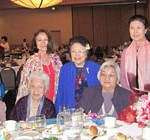
June 27, 2011, Sadao Tome, correspondent of Ryukyu Shimpo
The Downtown Los Angeles Chapter of the Japanese American Citizens League and the Japanese Women’s Society of Southern California selected women who made a contribution to the local Japanese community as the 2011 Women of the Year honorees, holding a celebration at a restaurant in Quiet Cannon, Montebello. Three hundred people attended the ceremony.
One of the five honorees who played an active role in the many diverse areas of the Japanese community of the United States is Nancy Nobu Nijima, who is originally from Okinawa Prefecture.
The first ceremony for the Women of the Year honorees was held in 1963, so this year’s were the 48th awards.
The Okinawa Association of America has been developing its profile, and is now well known within the Japanese society of Southern California and as a result, members of the Association have been selected as Women of the Year honorees for the past few years.
Well-versed in matters related to both music and cuisine Nijima, who is one of the 2011 Women of the Year honorees, has played the piano to entertain elderly residents at the Keiro Retirement Home.
She annually holds cooking classes of Okinawan cuisine at the Okinawa Association of America, and has been a columnist in the cooking section of the Rafu Shimpo, a Japanese-English language newspaper based in California, for the past 15 years.
Nijima married the late Takao Nijima, son of Masako Nijima, the founder of the Okinawa Professional Cooking College. She is also a daughter of Bunichi Shimabukuro, who was one of the founders of the University of the Ryukyus and was the first person to go from Okinawa to the United States to study after World War II.
With regard to being selected as a 2011 Women of the Year honoree, Nijima indicated her feelings of gratitude, saying “Nothing makes me happier than sharing the responsibility of helping to popularize Okinawan cuisine in the United States. I thank the many people who have supported me through the years. I wish that my late husband Takao could have been here to witness this proud moment.”
(English Translation by T&CT, Mark Ealey)
Go To Japanese

June 28, 2011 Ryukyu Shimpo
Thirteen year-old Miyu Kaname, from Urasoe City, is now steadily recovering, two months after undergoing heart transplant surgery at Columbia University hospital in New York City for restrictive cardiomyopathy. She had tests conducted under a microscope last week to check her muscle cell tissue, a sample of which was removed by means of cardiac catheterization. The doctor confirmed that her new heart has not been rejected and she is well after the operation.
Miyu is now having yoga lessons as recommended by an acquaintance. She enjoys them together with the yoga teacher’s daughter who is the same age as Miyu.
Her father Toshiaki said, “Yoga is hard for Miyu, but it is also good for her. The doctor gave her permission to do it. Yoga breathing helps the autonomic nervous system and she would like to continue with it.”
Office Miyu-Aid reports on what she has been doing lately in its blog. (http://www.miyu-aid.com)
(English Translation by T&CT, Mark Ealey)
Go To Japanese
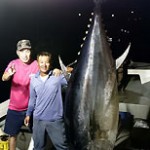
June 26, 2011 Yoko Morinaga, a correspondent of Ryukyu Shimpo
On June 16, off Kumejima Island, which is now in the middle of its fishing season, 45 year-old Hiroyuki Hirayama from Nagoya, Aichi Prefecture, caught a giant bluefin tuna weighing 286 kilograms and measuring 2.6 meters in length.
Hirayama returned to Kanegusuku port, where locals who had heard the news gathered and applauded his achievement, very happy at the sight of the shiny black tuna with its massive body.
While Hirayama was trolling with live bonito as bait under the guidance of the Taka Maru (Captain Takashi Nakamichi), a vessel belonging to the Fisheries Cooperative Association of Kumejima Island, he finally got a bite at 12:20pm. After about a six-hour struggle, the Nagoya man finally caught the fish.
Hirayama said happily,” I had been going after bluefin tuna for about six years now, and this one really gave me a good tussle.”
Nakamichi, who has been a captain now for five years, celebrated saying “Bluefin tuna is the fish that fishermen dream about catching. It must be my turn next!”
(English Translation by T&CT, Mark Ealey)
Go To Japanese
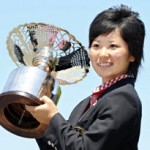
June 26, 2011 Ryukyu Shimpo
The final of the 53rd Japan Women’s Amateur Golf Championship 2011 was held in a match play (36 holes) format at Takarazuka Golf Club (6216 yards, par 72) in Hyogo Prefecture on June 25.
Seventeen year-old Mamiko Higa (third grade student of Motobu Senior High School) defeated Chihiro Ikeda (Philippines) with five holes remaining for her long-awaited first victory in the Japan Women’s Amateur Golf Championship.
She marks the fifth victory of Okinawan women golfers after a gap of six years, following on from Shinobu Moromizato in 2005, Mika Miyazato in 2004, Ai Miyazato in 2003, and Ayako Uehara in 2002.
With improving form from the first day, she came in to the match play tournament on the third day, winning by a wide margin. In the final, Higa scored an overwhelming victory over Ikeda to create a 7-up lead at the first half of 36 holes match play and then maintained the lead in the second half to secure the title.
(English Translation by T&CT, Mark Ealey)
Go To Japanese
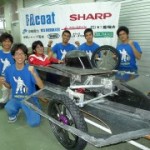
June 25, 2011 Ryukyu Shimpo
Team Okinawa (sponsored by The Ryukyu Shimpo Co. Ltd. and others), will participate in the 2011 World Solar Challenge, a solar-powered car race scheduled to be held in Australia this October. Team Okinawa has almost finished building its car for the race.
The car’s frame is covered with carbon fiber, which is also used for Formula One cars due to its lightness and strength, and the vehicle is equipped with custom-built wheels and tires that minimize the drag from friction.
Team Okinawa is scheduled to exhibit its solar car at the event plaza on the first floor of AEON Haebaru Store from 9:00am to 7:00pm on June 26 and to hold a press conference at which they will talk about their entry to the race. On the same day, at 2:00pm and 5:00pm, students of Nanbu Technical High School will give explanations about aspects of the solar car and talk about how they have prepared for the race. Members of the public will also be able to enjoy getting in the driver’s seat of the car.
Third-year student, 17 year-old Kousaku Kinjo, the captain of Team Okinawa, called for many people to come along to the exhibition, saying, “What we are now working on could lead to advances that will help protect the global environment. We would definitely like people to come to see our solar car and become interested in what we are doing.”
Team Okinawa is scheduled to take part in a solar car race held in Ogata, in Akita Prefecture from August 10.
Team Okinawa calls for support.
For details, call Team Okinawa at 070 (5400) 4618.
(English Translation by T&CT, Mark Ealey)
Go To Japanese
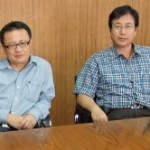
June 25, 2011 Ryukyu Shimpo
Later this year, a cargo ferry run by SinFa Transport Co., Ltd. (president Hsu Chih-hsiung and based in Taichung) will commence a regular service between Keelung in Taiwan and Ishigaki, Miyako in Okinawa. The president of the shipping company and Lie Kuen-Cheng, a member of the Taiwanese Legislative Council, visited the Ishigaki-jima to explain their plans to representatives of Taketomi, Ishigaki, and the Yaeyama Office of Okinawa Prefectural Government. After a gap of three years, a cargo ferry service going directly between Miyako, Yaeyama and Taiwan will recommence after the previous service was discontinued when the Arimura Sangyo Line went bankrupt in 2008.
The cargo vessel to service the route is registered in Panama and has a load-carrying capacity of 1500 tons.
The Taiwanese ferry company purchased a used vessel, which it is now refitting and will commence the once-a-week service in September at the earliest. Currently, the transportation of goods by sea between Taiwan and the Miyako, Yaeyama regions is via the main island of Okinawa, so this service will save both time and money by operating a direct route between Keelung and Ishigaki, Miyako.
Mayor of Ishigaki City, Yoshitaka Nakayama, welcomes the reopening of this route, saying, “There has been a decrease in the volume of imports from Taiwan since the Arimura Line discontinued the regular service. We need to promote economic exchange so as to achieve our goal of mutually prosperous interaction. For our part, we will also push along all kinds of exchange between Taiwan and the Yaeyama region.”
Legislator Lie said, “We have similarities in terms of our natural environment and in the economic situation of the eastern areas of Taiwan and Yaeyama. It would be good to be able to establish a closer relationship. I will work within the National Assembly of Taiwan to get daily flights going between our regions and will request government subsidies to help facilitate this,” he said.
The president of the shipping company stated, “Enhanced access to transportation will deepen the exchanges between us. The next step is to create a passenger ferry service.”
(English Translation by T&CT, Mark Ealey)
Go To Japanese
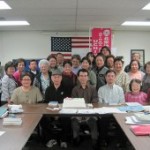
June 20, 2011 by Sadao Tome, correspondent of the Ryukyu Shimpo
Nine years have passed since 2002, when Chogi Higa started up Uchinaguchi (Okinawan language) classes as one of the cultural activities of the Okinawa Association of America.
Two-research scholars from the University of the Ryukyus went to observe the classes. In addition to their classroom visits, University of the Ryukyus professor Shinsho Miyara, the head of the Association of Okinawan Language Teaching, and Moriyo Shimabukuro, associate professor of University of the Ryukyus, conducted interviews with students and teachers and collected questionnaire survey sheets that had been sent to the class in advance.
The course was created to help keep the Okinawan language alive in the immigrant community in the United States as the number of first generation Okinawan immigrants who can speak Uchinaguchi decreases with the passage of time.
Content includes instruction in Uchinaguchi, Okinawan history, culture, customs and folk songs with humorous explanations used to explain the meanings of words.
Most of the students are second and third-generation Okinawan immigrants to the United States, second-generation Okinawan immigrants to South America, and Americans interested in Okinawa. Some Japanese students also participated in the class.
Each student brought some kind of Okinawan food along to the class and enjoyed each other’s company.
University students majoring in Asian studies or linguistics also took the class during their summer vacation and linguistics scholars from various Japanese universities visiting the class give it a unique atmosphere.
On the day in question, Higa taught the monthly Uchinaguchi class and had the students introduce themselves and give their opinions in a group discussion.
Professor Miyara explained the Association of Okinawan Language Teaching, saying “We teach Uchinaguchi to young children, and recently think that they are becoming even more enthusiastic about learning the language.”
Shimabukuro said, “We are making a textbook of Uchinaguchi in English, and plan to publish it through the University of Hawaii soon.”
Ryoko Onishi, who teaches Japanese at Los Angeles Harbor College and studies Japanese in University of California, Los Angeles, and Nobutaka Takara, Ph.D. Candidate in linguistics of University of California, Santa Barbara, participated in the class as guests.
(English Translation by T&CT, Mark Ealey)
Go To Japanese










 Webcam(Kokusai Street)
Webcam(Kokusai Street)


